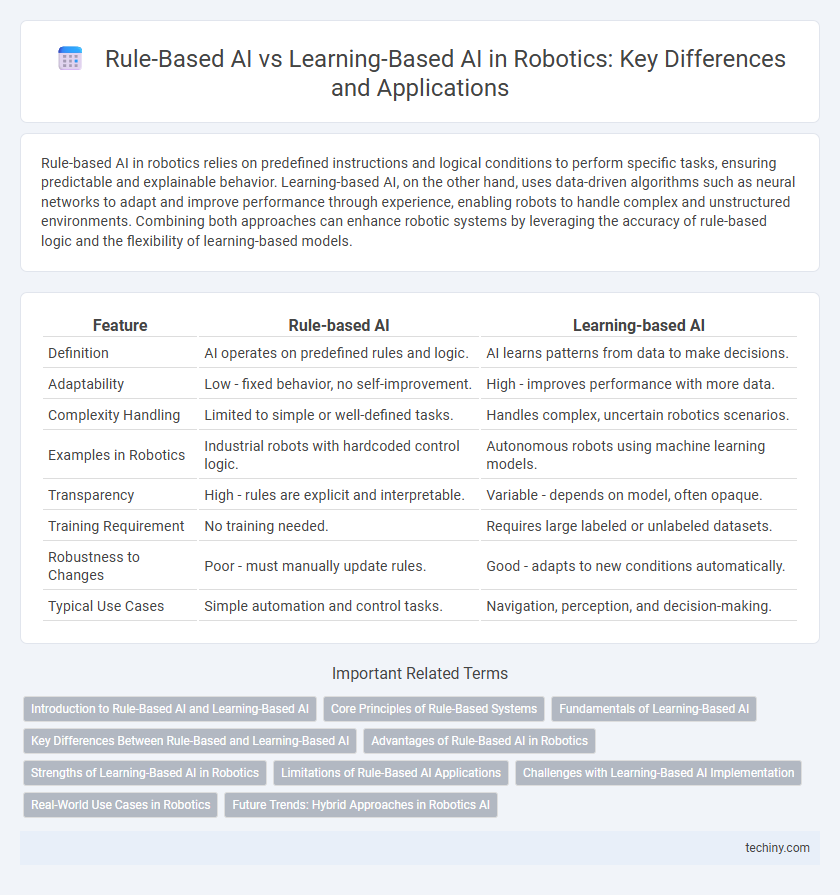Rule-based AI in robotics relies on predefined instructions and logical conditions to perform specific tasks, ensuring predictable and explainable behavior. Learning-based AI, on the other hand, uses data-driven algorithms such as neural networks to adapt and improve performance through experience, enabling robots to handle complex and unstructured environments. Combining both approaches can enhance robotic systems by leveraging the accuracy of rule-based logic and the flexibility of learning-based models.
Table of Comparison
| Feature | Rule-based AI | Learning-based AI |
|---|---|---|
| Definition | AI operates on predefined rules and logic. | AI learns patterns from data to make decisions. |
| Adaptability | Low - fixed behavior, no self-improvement. | High - improves performance with more data. |
| Complexity Handling | Limited to simple or well-defined tasks. | Handles complex, uncertain robotics scenarios. |
| Examples in Robotics | Industrial robots with hardcoded control logic. | Autonomous robots using machine learning models. |
| Transparency | High - rules are explicit and interpretable. | Variable - depends on model, often opaque. |
| Training Requirement | No training needed. | Requires large labeled or unlabeled datasets. |
| Robustness to Changes | Poor - must manually update rules. | Good - adapts to new conditions automatically. |
| Typical Use Cases | Simple automation and control tasks. | Navigation, perception, and decision-making. |
Introduction to Rule-Based AI and Learning-Based AI
Rule-based AI in robotics relies on explicitly programmed instructions that define specific actions and responses, ensuring predictable and interpretable behavior in structured environments. Learning-based AI, particularly through machine learning techniques such as neural networks, enables robots to adapt and improve performance by identifying patterns and making data-driven decisions without explicit programming. The contrast between these approaches highlights rule-based AI's strength in deterministic control and learning-based AI's advantage in flexibility and complex task handling.
Core Principles of Rule-Based Systems
Rule-based AI systems in robotics operate on explicitly programmed rules derived from expert knowledge, enabling precise decision-making through if-then logic. These systems rely on symbolic representation and deterministic algorithms, ensuring predictable and interpretable robot behavior in structured environments. Core principles include rule encoding, pattern matching, and inference mechanisms that guide robotic actions without the need for data-driven learning.
Fundamentals of Learning-Based AI
Learning-based AI in robotics fundamentally relies on data-driven models that enable machines to improve performance through experience without explicit programming. Techniques such as neural networks and reinforcement learning allow robots to adapt to dynamic environments by identifying patterns and optimizing actions based on feedback. This adaptability contrasts with rule-based AI, which depends on predefined instructions and lacks the flexibility to handle unforeseen scenarios.
Key Differences Between Rule-Based and Learning-Based AI
Rule-based AI in robotics operates on predefined if-then rules crafted by human experts, enabling predictable and transparent decision-making processes. Learning-based AI, particularly leveraging deep learning and reinforcement learning algorithms, adapts dynamically by analyzing large datasets to improve performance over time without explicit programming. Key differences include adaptability, where learning-based AI excels through continuous self-improvement, contrasted with rule-based AI's rigidity and limited scalability in complex or unpredictable environments.
Advantages of Rule-Based AI in Robotics
Rule-based AI in robotics offers high predictability and reliability by following explicitly programmed instructions, ensuring consistent performance in controlled environments. It enables easier debugging and validation since the decision-making process is transparent and interpretable. Rule-based systems require less computational power compared to learning-based AI, making them suitable for real-time applications with hardware constraints.
Strengths of Learning-Based AI in Robotics
Learning-based AI in robotics excels at adapting to dynamic environments through continuous data-driven improvements, enabling robots to perform complex, unstructured tasks with high accuracy. Techniques like deep learning and reinforcement learning empower robots to autonomously optimize behaviors, enhance object recognition, and improve decision-making under uncertainty. This adaptability leads to robust performance in diverse applications such as autonomous navigation, robotic manipulation, and human-robot interaction, surpassing the limitations of static rule-based systems.
Limitations of Rule-Based AI Applications
Rule-based AI in robotics is constrained by its inability to adapt to novel or unforeseen scenarios, as it strictly follows predefined rules without learning from experience. This rigidity limits its effectiveness in dynamic environments where diverse sensory inputs and context variations require flexible decision-making. Consequently, rule-based systems struggle with scalability and handling the complexity inherent in real-world robotic applications.
Challenges with Learning-Based AI Implementation
Learning-based AI in robotics faces significant challenges, including the need for vast amounts of high-quality training data and the difficulty of generalizing learned behaviors to diverse, unstructured environments. Model interpretability is limited, making debugging and safety assurance problematic in critical applications like autonomous navigation or manipulation. Furthermore, real-time adaptation requires substantial computational resources, often constraining deployment in low-power robotic systems.
Real-World Use Cases in Robotics
Rule-based AI in robotics excels in structured environments such as assembly lines and industrial automation, where predefined rules ensure high precision and reliability. Learning-based AI drives advancements in autonomous navigation and robotic grasping, adapting to dynamic, unstructured settings by leveraging sensor data and deep learning models. Real-world applications demonstrate that combining both approaches enhances performance in complex tasks like warehouse logistics and service robots.
Future Trends: Hybrid Approaches in Robotics AI
Hybrid approaches in robotics AI combine rule-based systems' precision with learning-based AI's adaptability, enabling robots to handle complex tasks more efficiently. Integrating symbolic reasoning with neural networks enhances decision-making capabilities and accelerates real-time problem solving in dynamic environments. Emerging trends emphasize seamless collaboration between these methods to improve robustness and flexibility in autonomous robotic systems.
Rule-based AI vs learning-based AI Infographic

 techiny.com
techiny.com